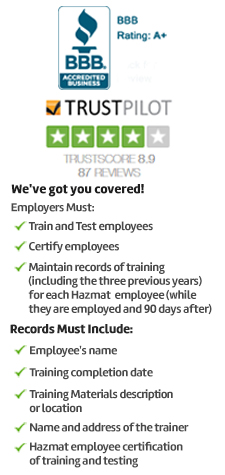
IATA DGR Shipping Training

This online training course has been formulated to satisfy all safety standards prescribed for air transporters handling dangerous goods including FedEx and UPS.
Students are trained how to follow the IATA Dangerous Goods Regulations, responsibilities of air cargo handlers and operators, safe methods to identify hazardous goods and procedures to pack, handle, document, mark, label and load dangerous goods.
Governing regulations
This training course meets the IATA DGR hazardous material training needs for air operators who are shipping any of the nine categories of dangerous goods.
Who must take this course?
IATA DGR regulations stipulates that regular training should be given to people who are mentioned in Table 1.5.A (Airline goods acceptance staff, packers, shippers and shipment forwarders; freight training and development experts; Ground handling and load control workers associated in the cargo supply chain; Regulatory enforcement specialists; Operations and station officers; and security staff).
How long is the course?
The online course will take MINIMUM 6 hours to complete successfully. To make it convenient for students and workers who have other commitments, they can log on and off as per their free time. They can create a bookmark whenever they log off and can come back to log in again to resume their studies.
How soon is the certificate of completion issued?
Students once they complete the course will get immediate access to a printable course certificate and wallet card as a proof of training on IATA DGR Shipping Hazmat by Air.
How long do I have to complete this course?
We don’t put restriction on students to complete the course with in a specific time. They can decide their course duration and complete it. We also offer employers and transport workers to purchase courses for others and decide any time frame to assign the courses. Similarly, you can purchase huge quantity of courses and avail volume discounts.
Continuing education credits?
Each passing student will get 0.6 CEUs (or 6 CMEs) from Compliance Training Online® for successfully completing the training.
Course Format
Our IATA Dangerous Goods Regulations training and certification course has been provided with high quality content, well made graphics and audio presentations, huge question bank for excellent practice and the final exam.
Course synopsis
This online training course covers all basic concepts of how safely one can carry hazardous materials via airplane while following all mandatory IATA Dangerous Goods Regulations. Students also provided with information on shipment operators and handlers’ responsibilities, methodology to identify, lift, mark, label, pack, document, handle and load consignments carrying dangerous goods. Learners further made to analyse statistical information and case studies to have better understanding and knowledge on providing safe transport of dangerous items via air.
How often is retraining or recertification required?
As per the regulations of IATA DGR, workers and people associated with carrying or handling dangerous goods through airplanes should be given frequent training (at least once in every two years) to sharpen their cargo handling knowledge and skills.
Continuing education credits?
Each passing student will get 0.6 CEUs (or 6 CMEs) for successfully completing the training.
Topics Covered
- About This Course
- Course Objectives
- Introduction to Dangerous Goods Regulations
- Philosophy of Dangerous Goods Regulations
- Key Terms and Concepts
- Dangerous Goods Incidents and Statistics
- How to Use the DGR
- Changes to the 59th Edition
- Applicability
- Basis of the IATA Dangerous Goods Regulations
- Application of the Regulations
- Shipper’s Responsibilities
- Operator’s Responsibilities
- Training
- Adequate Instruction for Shipping Section II Lithium Batteries
- Security
- Limitations
- Forbidden Dangerous Goods
- Hidden Dangerous Goods
- Dangerous Goods Carried by Passengers or Crew
- Dangerous Goods Transported by Post
- Operator’s Property Exceptions
- Excepted Quantities
- Limited Quantities
- Variations
- Classification
- Packing Groups
- Shipper’s Responsibilities
- Multiple Hazards
- Samples
- Identification
- Selecting the Proper Shipping Name
- Using the List of Dangerous Goods
- Packing
- Shipper’s Responsibilities
- Overpacks
- Salvage Packaging
- General Packing Requirements
- Specific Packing Instructions
- Packaging Specifications and Performance Tests
- Codes
- Markings
- Requirements for Inner Packagings
- UN Outer, Single, and Composite Packagings
- General Testing Requirements
- Types of Tests
- Test Reports
- Specific Testing Requirements
- Marking and Labeling
- Markings
- Labels
- General Label Specifications
- Hazard Labels
- Handling Labels
- Documentation
- Shipper’s Declaration
- Completing the Shipper’s Declaration
- Air Waybill
- Additional Documentation
- Handling
- Acceptance
- Loading
- Inspections
- Provisions for Pilot-in-Command
- Informing Passengers and Shippers
- Reporting
- Document Retention
- Class 1 Explosives
- Definitions
- Primary Hazards
- Six Divisions
- Thirteen Compatibility Groups
- Classification
- Exclusions and Limitations
- Packing Instructions
- Labels
- Class 2 Gases
- Definitions
- Primary Hazards
- Three Divisions
- Exemptions
- Limited and Excepted Quantities
- Mixtures and Hazard Precedence
- Aerosols and Aerosol Dispensers
- Packing Instructions
- Packaging Specifications
- Class 3 Flammable Liquids
- Definitions
- Flammable Liquids
- Liquid Desensitized Explosives
- Primary Hazards
- Packing Group Criteria
- Limited and Excepted Quantities
- Packing Instructions
- Class 4 Flammable Solids
- Flammable Solids
- Self-reactive Substances
- Desensitized Explosives
- Division 4.1
- Division 4.2-Substances Liable to Spontaneous Combustion
- Division 4.3-Substances Which, in Contact with Water, Emit Flammable Gases
- Excepted and Limited Quantities
- Packing Instructions
- Class 5 Oxidizing Substances and Organic Peroxides
- Oxidizing Substances
- Organic Peroxides
- Classification
- Temperature Controls
- Desensitization
- Exceptions, Limitations, and Labels
- Packing Instructions
- Class 6 Toxic and Infectious Substances
- Toxic Substances
- Classification of Toxic Substances
- Classification of Toxic Mixtures
- Limitations and Labels
- Infectious Substances
- Classification of Infectious Substances
- Exceptions
- Patient Specimens
- Medical Devices
- Biological Products
- Packing Instructions-Category A Infectious Substances
- Packing Instructions-Biomedical Waste
- Packing Instructions-Category B Biological Substances
- Handling
- Class 7 Radioactive Material
- Definitions
- Hazards
- Limitations
- Classification
- Special Form
- Low Specific Activity (LSA) Material
- Surface Contaminated Objects (SCO)
- Fissile
- Low Dispersible Radioactive Material
- Subsidiary Risks
- Packing
- Before Shipment Requirements
- General Requirements
- Excepted Packages
- Industrial Packages
- Type A Packages
- Type B(U) and B(M) Packages
- Type C Packages
- Fissile Material
- Uranium Hexafluoride
- Transport Index and Criticality Safety Index
- Marking
- Labeling
- Documentation
- Competent Authority Certificates
- Handling
- Storage and Loading
- Class 8 Corrosives
- Packaging Group Criteria
- Limitations
- Excepted and Limited Quantities
- Packing Instructions
- Labels
- Class 9 Miscellaneous
- Labels
- Limitations
- Dry Ice
- Packing Instructions
- Documentation
- Handling
- Lithium Batteries
- Primary Hazard
- Classification
- Packing Instructions
- Labels
- Special Provisions
- Limitations
- Magnetized Material
- Packing Instructions
- Handling Label
- Loading
- Summary
- Additional Resources

 NEBOSH CERTIFICATE
NEBOSH CERTIFICATE NEBOSH DIPLOMA
NEBOSH DIPLOMA IOSH
IOSH SAFETY DIPLOMA
SAFETY DIPLOMA CPD UK
CPD UK ROSPA UK
ROSPA UK FOOD SAFETY
FOOD SAFETY 



